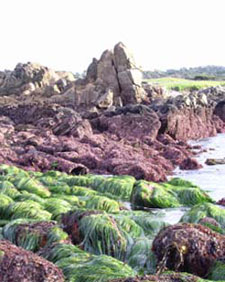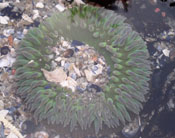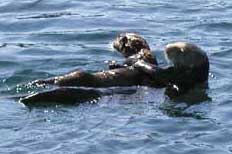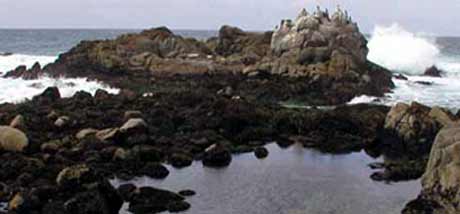Resource Issues: Wildlife Disturbance
 Overview of the issue:
Overview of the issue:
The Sanctuary provides many opportunities for observation of nature, including whale watching, bird watching, pinniped pupping and haulout activity, and viewing of sea otters. Rocky shorelines provide pedestrians opportunities to view the flora and fauna associated with the intertidal habitat, and kayaks and partyboats are used for nearshore and offshore tours. With the multitude of opportunities for observation come the potential for wildlife disturbance that may result in flushing birds from their nesting roosts, harassment or even death of pinnipeds or sea otters, as well as trampling and excess collecting of intertidal organisms. Other sources of wildlife disturbance include low-flying aircraft, fireworks displays that can flush seabirds and marine mammals, marine debris, acoustic impacts and motorized personal watercraft.
The Sanctuary has one of the most diverse and abundant assemblages of marine animals in the world, including six species of pinniped, twenty-seven species of cetacean, four species of sea turtles, ninety-four species of seabirds and one species of sea otter (fissiped). Nearly all of the mammal and turtle species, and many birds, are protected under the Endangered Species Act, Marine Mammal Protection Act or Migratory Bird Treaty Act.
How is the Sanctuary involved?
MBNMS addresses wildlife disturbance through a mix of educational outreach, regulations and enforcement. Sanctuary regulations explicitly prohibit harassment of marine mammals, as defined under the Marine Mammal Protection Act.
The Sanctuary is mandated to approach resource protection from a broad, ecosystem based perspective. This requires consideration of a complex array of habitats, species, and interconnected processes and their relationship to human activities. 
Public awareness is necessary to effectively address wildlife disturbance issues since most people who choose to view marine wildlife do not intend to place the animals or themselves at risk. While it has been well established that it is harmful and dangerous to closely approach, handle or feed terrestrial wildlife (e.g., bears, deer, raccoons, nesting birds, etc.), many people do not yet seem to understand that these concerns also apply to marine wildlife.
Potential Disturbance Activities within the MBNMS
Over the last twenty years, increasing numbers of people have been seeking opportunities to view and experience marine wildlife. For the most part, wildlife viewing has resulted in many positive benefits including new economic opportunities for local communities, and increased public awareness and stewardship for marine resources. However, there is growing evidence that marine wildlife can be disturbed and/or injured when viewing activities are conducted inappropriately. Disturbance or injury also occurrs through commercial harvest activities.
Frequent disturbance can adversely affect marine species. The effects of disturbance can be especially critical during sensitive time periods, such as feeding, breeding, resting, or nesting. Disturbance is likely to cause avoidance reactions and may result in interruptions of social behavior of animals and is capable of leading to long-term changes in distribution.
How You Can Help Protect Wildlife
Types of Wildlife in the MBNMS
MBNMS is known both nationally and internationally as a veritable 'hot spot' for viewing marine life. Of the more than 116 federally listed threatened or endangered species (55 percent of all species nationwide) in California, twenty-six reside within the Sanctuary. There is significant interest and public participation in activities found in the region that offer wildlife viewing. Following is a description of wildlife species present in the MBNMS which are subject to disturbance.

Cetaceans
Monterey Bay National Marine Sanctuary boasts some of the most diverse and abundant marine mammal assemblages in the world. This is due to a number of factors, such as the region’s location on a migration pathway between Arctic feeding grounds and warmer breeding areas, the waters’ great productivity, and great habitat diversity. The region’s marine mammal community is a mix of permanent and seasonal residents as well as species that use these waters for shorter periods – either as a feeding destination or in transit during long-distance migratory journeys (such as gray whales). Sanctuary waters are also important to several marine mammal species that are considered of special concern because of their reduced or declining populations. Five species seen in the sanctuary are listed as endangered: the blue, fin, humpback, right, and sperm.
 Pinnipeds
Pinnipeds
There are a total of nine rookeries/colonies in MBNMS. The five species of pinnipeds considered common in the Monterey Bay area include California sea lions, steller sea lions, northern elephant seals, northern fur seals, and Pacific harbor seals. An additional species, the Guadalupe fur seal, has been reported from records of sick animals stranded on the beach.
Fissipeds
 The California or Southern sea otter is a threatened species that is found throughout the shallow waters of Monterey Bay National Marine Sanctuary, with its broader range stretching from the Gaviota Coast in Santa Barbara County to Half Moon Bay in San Mateo County. Sea otters inhabit a narrow zone of coastal waters, normally staying within one mile from shore. They forage in both rocky and soft-sediment communities as well as in the kelp understory and canopy. They seldom are found in open waters deeper than 30m, preferring instead the kelp beds, which serve as vital resting, foraging, and nursery sites. Otters are an important part of the marine ecosystem. By foraging on kelp-eating macroinvertebrates (especially sea urchins) sea otters can influence the abundance and species composition of kelp assemblages and animals within nearshore communities.
The California or Southern sea otter is a threatened species that is found throughout the shallow waters of Monterey Bay National Marine Sanctuary, with its broader range stretching from the Gaviota Coast in Santa Barbara County to Half Moon Bay in San Mateo County. Sea otters inhabit a narrow zone of coastal waters, normally staying within one mile from shore. They forage in both rocky and soft-sediment communities as well as in the kelp understory and canopy. They seldom are found in open waters deeper than 30m, preferring instead the kelp beds, which serve as vital resting, foraging, and nursery sites. Otters are an important part of the marine ecosystem. By foraging on kelp-eating macroinvertebrates (especially sea urchins) sea otters can influence the abundance and species composition of kelp assemblages and animals within nearshore communities.
 Seabirds and Shorebirds
Seabirds and Shorebirds
Sanctuary waters are among the most heavily used by seabirds worldwide. Ninety-four species of seabird are known to occur regularly within and in the vicinity of the Sanctuary, and approximately ninety species of tidal and wetland birds occur on the shores, marshes, and estuaries bordering Sanctuary waters. Several environmental features are responsible for the diverse assemblage of birds in the area. The Monterey Bay is located on the "Pacific Flyway", allowing migratory birds a place to stopover during both north and south migrations between southern wintering grounds and northern breeding sites. The upwelling of nutrient-rich waters support highly productive food webs which provide abundant seabird prey, as well as the diversity of habitat types along the shore which increases the variety of bird species utilizing the MBNMS. Thus, many birds found in Sanctuary waters have come to feed, some from as far as New Zealand.
Turtles
 Four species of sea turtles have been noted in sanctuary waters — the Green, Pacific Ridley, Leatherback and Loggerhead sea turtles. The Leatherback is the most common, sometimes seen from ocean-going fishing or wildlife–watching boats. It is the largest turtle in the world and has the widest geographic range of any reptile. Loggerhead and Olive Ridley are rarely seen.
Four species of sea turtles have been noted in sanctuary waters — the Green, Pacific Ridley, Leatherback and Loggerhead sea turtles. The Leatherback is the most common, sometimes seen from ocean-going fishing or wildlife–watching boats. It is the largest turtle in the world and has the widest geographic range of any reptile. Loggerhead and Olive Ridley are rarely seen.
To help protect wildlife, be sure to follow the Office of National Marine Sanctuaries responsible wildlife viewing guidelines.

RELATED LINKS:
- The SIMON site marine mammal overview
- NOAA Fisheries – Office of Protected Resources
- Marine Mammal Center
